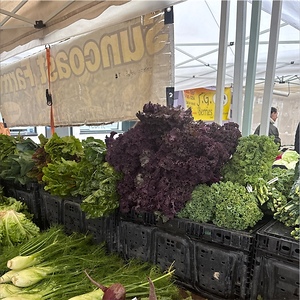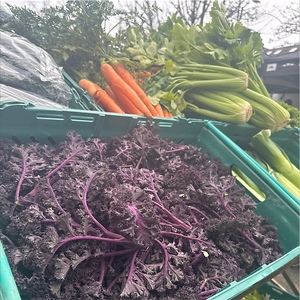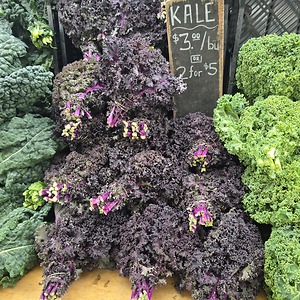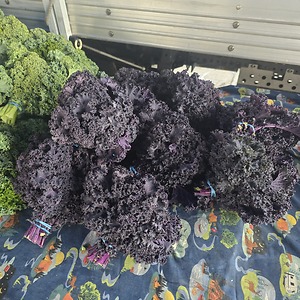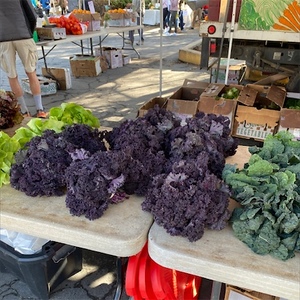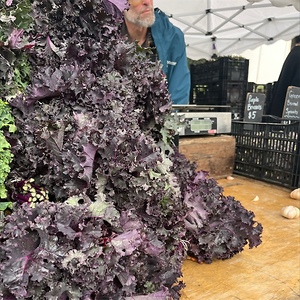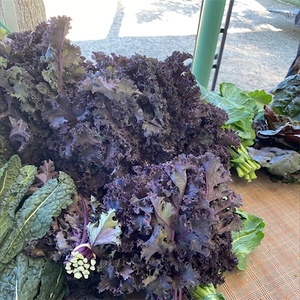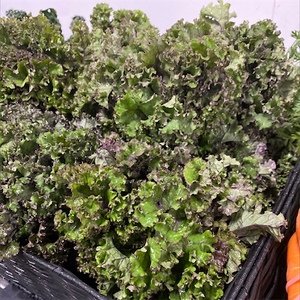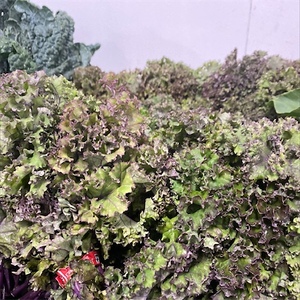

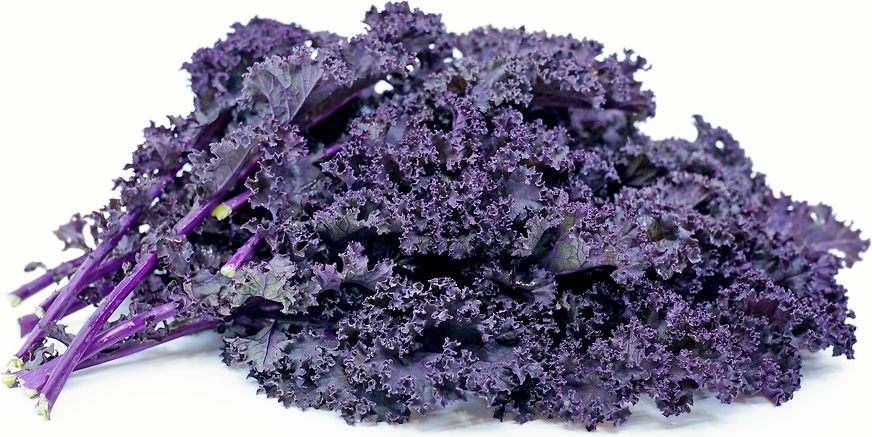
Redbor Kale
Estimated Inventory, bunch : 0
This item was last sold on : 12/01/22
Description/Taste
Redbor kale varies in size, depending on its age at harvest, and can be picked when the leaves are small and delicate or mature, growing as large as 60 centimeters in length. The plants are comprised of central, fibrous, strong, and firm stems with deeply veined, frilled, and curled leaves. The leaf’s surface is crinkled, slightly raised, and thicker in nature. Redbor kale fluctuates in color throughout the season with changing temperatures and soil quality. The leaves and stems acquire deep red, burgundy, and purple hues, and some leaves are tinged with matte, dark green patches. The leaves also bear a crisp texture and can be tender or slightly chewy and fibrous, altering with age. Redbor kale is typically harvested in its baby stage when it is delicate, succulent, and crisp or when it is mature but still softer and less fibrous. The variety has an earthy, nutty, grassy, bitter, and vegetal taste when raw, becoming sweeter and milder once cooked.
Seasons/Availability
Redbor kale is available in the late fall through early spring.
Current Facts
Redbor kale, botanically classified as Brassica oleracea, is a pigmented, cool-season variety belonging to the Brassicaceae family. The curled, frilled leaves grow on upright plants, and at maturity, the plants can reach up to 1.2 meters in height. Redbor kale is a part of the vegetable kale group rather than the ornamental group, but home gardeners favor the variety for its multi-purpose nature. The cultivar is famous for its cold tolerance and becomes more colorful and sweeter in flavor after exposure to freezing temperatures. Redbor kale is planted in gardens for its visual aesthetic and as a culinary green. The leaves have a distinct, textured feel and can be individually removed from the plants throughout the season, allowing for an extended season. Redbor kale can be harvested at its baby stage, around 28 days after planting, or it can be picked slightly older but still tender, between 55 to 75 days. The variety is grown worldwide as a fall and winter crop, and the leaves are edible raw or cooked in a wide array of savory culinary preparations.
Nutritional Value
Redbor kale is a source of vitamins A, C, and K to maintain healthy organs, aid in faster wound healing, and strengthen the immune system. Kale also provides fiber to regulate the digestive tract and minerals, including iron, potassium, magnesium, phosphorus, calcium, and copper. Iron develops the protein hemoglobin for oxygen transport through the bloodstream, while potassium balances fluid levels within the body. Magnesium helps to control nerve functions, calcium and phosphorus support bones and teeth, and copper assists the body in forming collagen. Beyond vitamins and minerals, Redbor kale contains anti-inflammatory and antioxidant properties to protect the body’s overall health.
Applications
Redbor kale has an earthy, grassy, and subtly sweet taste suited for fresh and cooked preparations. The leaves should be trimmed of any rough or excessively fibrous portions, and it is recommended to chop, tear, or cut the leaves before use. Massaging the chopped leaves with olive oil will help soften their tough nature, and after this process, the greens can be tossed into salads or served with nuts and aromatics as a side dish. Redbor kale is known for its coloring when used raw and is sometimes added to pesto or blended into smoothies. Once cooked, the leaves do lose pigmentation and become less vibrant. The greens can be steamed to help preserve their coloring or stir-fried and combined with meats and other vegetables. Try incorporating Redbor kale into soups, curries, and stews or mixing the greens into noodle and rice dishes. The leaves can be shredded and layered into quesadillas or used as a unique taco topping. They are also added to grain bowls, mixed into fillings for stuffed sweet potato and squash, or cooked into frittata and other egg-based dishes. Redbor kale can be used interchangeably in recipes calling for curly kale. They can be combined with mashed potatoes, added to pasta and lasagna, or baked into a crisp, healthy, chip-like snack. Redbor kale pairs well with herbs such as sage, dill, oregano, and thyme, nuts including pine, almonds, and walnuts, avocado, carrots, mushrooms, radishes, tomatoes, and parmesan cheese. Whole, unwashed Redbor kale will be kept for 5 to 7 days when stored in a loose plastic bag with a paper towel to absorb excess moisture in the refrigerator. Kale can also be blanched and frozen for extended use.
Ethnic/Cultural Info
Redbor kale was the first edible plant selected by the Louisiana Super Plant Program in 2011. The educational program was established by Louisiana State University’s AgCenter in 2009 to promote favorable landscape plants for Louisiana residents. The southern state is known for its high heat and humidity, creating an environment that requires specific qualities in home garden plants. The Louisiana Super Plant Program utilizes the university’s research to choose hardy plants, and each selected item is trialed and evaluated for over two years before it is promoted. A Louisiana Super Plant Advisory Committee was also established with industry professionals from across the state to help market the selected plants under the slogan “University tested and industry approved.” The Louisiana Super Plant Program was officially launched in 2010, and Redbor kale was the first multi-use edible plant featured through the program in 2011.
Geography/History
Redbor kale is a descendant of ancient kale species native to regions within the Eastern Mediterranean, Asia Minor, and the Middle East. Wild species of Brassica oleracea have been naturally growing since ancient times and were eventually domesticated for medicinal and culinary use. Early domesticated types were grown in Ancient Greece and Rome, and over time, improved varieties were spread across Asia and Europe. The exact origins of Redbor kale are unknown, but some sources hypothesize that one of the parent varieties may be Baltic Red, an heirloom cultivar from the Baltic Region in northeastern Europe. Kale, in general, was introduced to the United States in the 17th century through European settlers and again in the late 19th and early 20th centuries through agricultural explorer for the USDA, David Fairchild. Redbor kale received the Award of Garden Merit in 1999 through the Royal Horticultural Society in England and was reconfirmed in 2015. This award is a prestigious title that recognizes plant varieties with exceptional growth characteristics for home gardens. Today, Redbor kale is a favored garden cultivar offered through nurseries and seed catalogs worldwide, especially in North America and Europe. The variety is also grown in small commercial quantities as a specialty green through select farmer’s markets and wholesalers.
Recipe Ideas
Recipes that include Redbor Kale. One
| Lisa is Cooking |
|
Greens with Red Beans, Cilantro, and Feta Cheese |
Podcast



